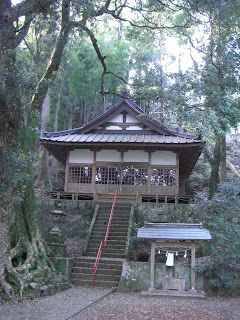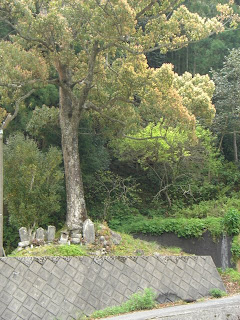It started at the end of March. The rice-fields were ploughed and checked for leaks. And the rice was seeded in trays. The trays were inti tally placed in a warm incubator and after a couple of weeks they were placed outside in the sun to grow.

So after a month we are ready for planting. The first step is to flood the fields and let water sink into the ground to make mud. The next step is to spread fertilizer over the fields. The old way is to squelch across the field flinging the fertilizer around. But now we thave a 'ghostbusters' machine which can fire the fertilizer across the field from the edges. This is Masahiko-san with the 'ghostbusters' machine in the lower fields.

Then the field is ploughed twice to turn it into smooth mud. This is Takashi-san on the tractor with Naomi supervising.

This is Takashi-san again doing the second round of ploughing in the upper field. The rake behind the tractor is smoothing out the mud.
Then the field needs to be smoothed out to eliminate any peaks or troughs. This is hard work because the mud is heavy but very important. The the rice is planted a couple of centimeters under water. If the field is uneven some of the rice will be too deep or to shallow and won't grow properly.


Now the field is ready for the rice seedlings which have been happily growing in their trays and are now about 5cm tall. Before they are planted they get a dusting of 'magic powder' (fungicide and insecticide) and a final watering to spread it around.


And now for the really cool part. In the old days the rice seedlings was planted by hand which much have been a horrible job. Now we have a cute little machine which pretty much does everything except drink the beer at the end of the day.
As you can see here.


To load the machine, the 'turfs' of rice seedlings are unrolled from their trays and rolled onto the magazine at the back. The magazine slides sideways a bit like like a typewriter and 4 mechanical hands pick out little squares of seedlings and place them into the mud at precise depth and intervals.
This is me driving the cute rice-planting machine. ('Cute' really is the brand of the machine).

The machine even has a guide rail that makes a furrow in the mud at the precise distance for the next pass so all you have to do is aim the machine at it. And it beeps when its time to reload.

Its also a good spot for watching frogs.
The final step is to fill in any gaps by planting by hand.

In the backgound you can see Masahiko-san as Yasuyo fixing up the fence. The upper field is right by the edge of the forest and needs a high fence to stop wild deer and pigs trampling the field and eating the rice plants.

I noticed frogs hiding in the fence-posts.

At 5 o'clock the village public-address system plays a tune to tell everyone its time to finish work and go home for a cold beer. You can hear the frogs applauding our work.













